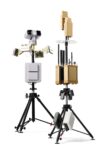In a rare and strategically significant air combat drill over the Arabian Sea, British F-35B Lightning II fighters from HMS Queen Elizabeth squared off against Indian Air Force (IAF) Su-30MKI Flankers and Jaguar strike aircraft during Exercise Konkan Shakti 2025. The bilateral exercise tested joint air-sea integration and featured a simulated carrier strike scenario that pitted fifth-generation stealth fighters against fourth-generation multirole platforms.
A Unique Fifth-vs-Fourth Generation Match-Up
The highlight of the exercise was a mock carrier strike launched by the UK’s Carrier Strike Group (CSG), centered around HMS Queen Elizabeth. The offensive involved F-35Bs from 617 Squadron RAF simulating an air raid on Indian naval assets while being intercepted by IAF Su-30MKIs and SEPECAT Jaguars operating from shore-based airfields. According to official statements from both nations’ defense ministries, this was one of the first times that British fifth-generation fighters directly engaged in dissimilar air combat training (DACT) with India’s frontline fourth-generation aircraft.
The Royal Navy deployed its full complement of embarked assets for the exercise including:
- F-35B Lightning II STOVL jets (617 Squadron RAF)
- Merlin HM2 ASW helicopters
- Wildcat HMA2 maritime helicopters
The IAF responded with a composite force package including:
- Sukhoi Su-30MKI multirole fighters equipped with Astra BVRAAMs
- SEPECAT Jaguar IS/IM aircraft configured for maritime strike roles
- Netra AEW&C aircraft based on Embraer ERJ145 platform
Exercise Konkan Shakti: Expanding Scope of Indo-British Interoperability
Konkan Shakti is a biennial trilateral exercise involving the Indian Navy (IN), Indian Air Force (IAF), and British Royal Navy. The latest iteration in October 2025 marked an evolution in complexity and scale. For the first time, it included integrated carrier operations with fifth-generation aircraft operating under real-world electronic warfare conditions.
The drills were conducted over multiple phases:
- Phase I: Harbor planning drills in Mumbai focused on C4ISR coordination between fleet commands.
- Phase II: Sea phase involving anti-submarine warfare (ASW), surface action group maneuvers, and live-fire gunnery exercises.
- Phase III: High-end joint air-sea combat simulation involving contested A2/AD environments.
This year’s scenario envisioned a simulated adversary naval task force approaching India’s western seaboard. British F-35Bs were tasked with penetrating contested airspace to execute precision strikes while evading or defeating IAF interceptors supported by ground-based radar networks and airborne early warning assets.
Tactical Lessons: Stealth Penetration vs Legacy Radar Networks
The engagement offered valuable insights into how stealth platforms like the F-35B perform against legacy radar-guided interceptors such as the Su-30MKI when supported by airborne early warning systems like Netra AEW&C. While official results are classified, defense sources indicated that the F-35Bs successfully executed their simulated strike missions without being “killed” in most scenarios—highlighting their survivability even within dense radar environments.
A key advantage was networked sensor fusion via Link 16 data links between Royal Navy vessels and airborne platforms. This allowed F-35s to receive cueing from offboard sensors without emitting detectable signals themselves—preserving low observability while enhancing situational awareness.
The IAF reportedly used its Su-30MKIs’ powerful N011M Bars radar arrays to try to detect low-flying threats while coordinating with Netra AEW&C for vectoring intercepts. However, limitations in radar horizon and clutter discrimination at sea-level altitudes hampered detection effectiveness against stealthy targets flying nap-of-the-earth profiles.
A Platform Comparison: Capabilities of Participants
F-35B Lightning II (UK)
- Role: Multirole stealth fighter; STOVL variant for carrier ops
- Sensors: AN/APG-81 AESA radar; DAS; EOTS; MADL & Link16 comms
- Munitions: AIM-120D AMRAAM; Paveway IV; SPEAR III (in future)
- Tactics: First-look/first-shot capability; passive kill chains via sensor fusion
Sukhoi Su-30MKI (India)
- Role: Heavy multirole fighter with long endurance & payload capacity
- Sensors: N011M Bars hybrid PESA radar; IRST; Astra missile integration
- Munitions: Astra Mk1/Mk2 BVRAAMs; Kh-series anti-shipping missiles; R73/Vympel short-range AAMs
- Tactics: Long-range patrols & vectoring via AEW&C support for area denial missions
Jaguar IS/IM Maritime Strike Aircraft (India)
- Status: Aging but upgraded deep-strike platform nearing retirement (~2030)
- Missions: Anti-shipping strikes using Sea Eagle missiles or dumb bombs under visual guidance or LDP support
AWE&C Support – Netra ERJ145 Platform (India)
- Covers ~240-degree sector surveillance up to ~250 km range depending on altitude;
This mix of platforms created an asymmetric engagement environment where stealth versus sensor density became a key variable rather than raw kinematic performance alone.
Larger Strategic Implications for Indo-Pacific Security Architecture
This high-end bilateral training aligns with broader UK goals under its “Global Britain” defense posture which aims to maintain persistent presence across Indo-Pacific sea lanes. For India, it offers exposure to advanced Western tactics—particularly around low-observable threat detection—and refines joint operational doctrines relevant to its own future acquisition plans such as MRFA (Multi Role Fighter Aircraft) program where platforms like Rafale or even potential F/A‑18E/F are contenders alongside indigenous options like HAL AMCA.
The exercise also underscores growing interoperability between NATO-aligned forces and India as it balances strategic autonomy with enhanced military cooperation across QUAD-aligned partners including Japan and Australia. With China’s expanding naval footprint across the Indian Ocean Region (IOR), these exercises serve both deterrence signaling functions as well as genuine capability development benchmarks for regional security stakeholders.
The Road Ahead: Future Exercises and Technology Transfers?
The success of Exercise Konkan Shakti may pave the way for more complex trilateral or multilateral engagements involving other QUAD nations or EU partners such as France. There is also speculation about deeper industrial collaboration between BAE Systems/Rolls Royce and India’s DRDO/HAL ecosystem—potentially around engine tech sharing or carrier aviation expertise transfer related to India’s INS Vikrant program.
If future iterations include live missile firings or contested electromagnetic spectrum operations involving jamming/spoofing elements, they could further expand tactical realism—especially relevant given increasing EW threats across modern theaters of operation from Ukraine to Taiwan Strait scenarios.









